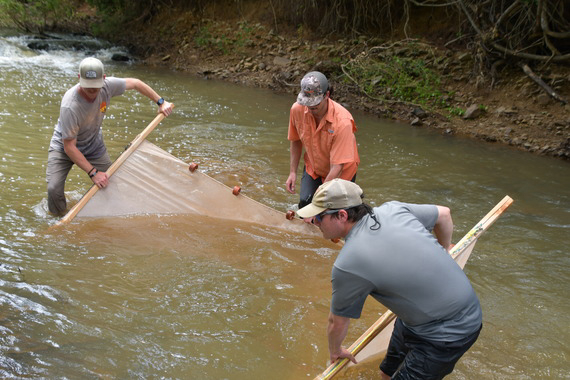
|
The Wildlife Department never misses a chance to celebrate a season opener like this summer’s start of the Streams Program’s community sampling efforts. But this year's surveys are especially exciting as they mark a decade of data collection of Oklahoma’s fish and streams habitat.
“Our goal is to survey Oklahoma’s streams and develop the most updated range information for nongame fishes,” said Eric Cox, fisheries biologist with the Streams Program. “Then we can determine what characteristics those species prefer to inhabit.”
The Streams Program began surveying Oklahoma’s waterways in 2016 and has rotated its target watersheds with the years. This year’s efforts will focus on the Poteau River drainage in southeastern Oklahoma. Nearly 40 sites will be monitored throughout the drainage, spanning from Wilburton to Pocola and down Hodgen. Also on this year’s schedule are sites in the Lower Red River, below Lake Texoma’s Denison Dam.
“There’s an incredible amount of fish diversity in these watersheds,” said Devlin Carraway, another fisheries biologist with the Streams Program. “We’ve already encountered several beautiful mountain fish this year but will also likely encounter species like shovelnose sturgeon and alligator gar.”
Regardless of the survey site’s location in the state, the community sampling team uses standardized procedures to document the fish community and habitat characteristics at each site. Between seines, electrofishing gear, and “fyke” nets or traps, biologists can effectively sample different habitats and document fish of different sizes and with different behaviors. The team also takes a variety of measurements to learn more about the stream’s flow, clarity, width, and depth. By returning to the same sites every 5 – 10 years, pending landowner permission, biologists can compare the presence or absence of species with the stream’s current characteristics.
When the community sampling data are compiled and analyzed, biologists will be able to determine which species regularly occur in which habitats. Knowing a certain species prefers, for example, cobble streams with woody debris and swift-moving waters not only helps in current management efforts but would be beneficial should the species experience population or range declines.
“This is an incredibly important data set,” Cox said. “Very few surveys and monitoring efforts are this focused on nongame fishes, and we’re getting to collect data across the entire state.”
Community sampling efforts are funded by the Wildlife Department with support from the U.S. Fish and Wildlife Service’s Sportfish Restoration Grant F24AF00402.